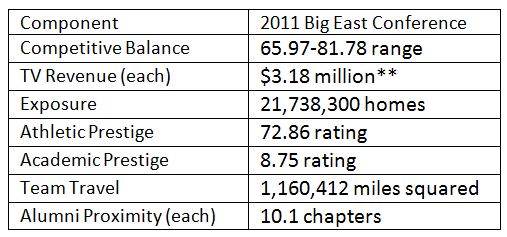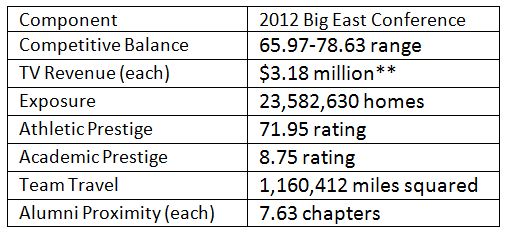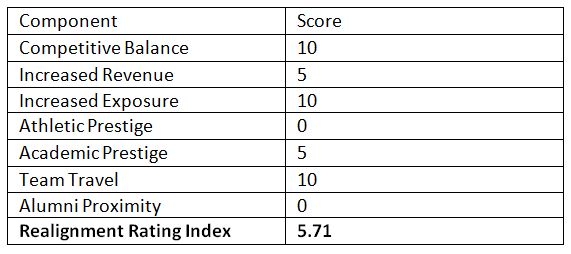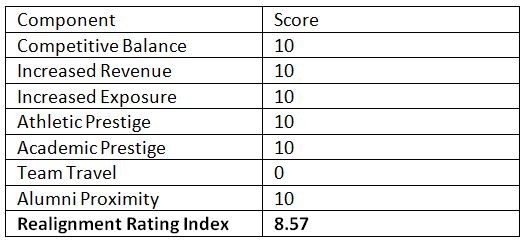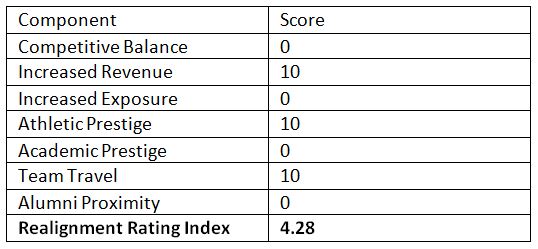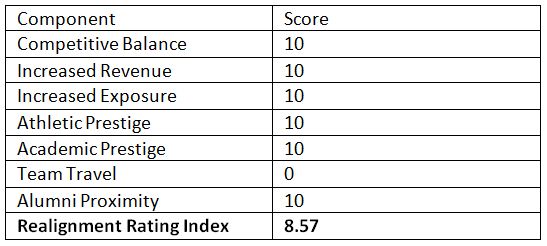By: G.K. Nwosu, Doctoral Student-University of Nevada Las Vegas
In The Realignment Rating Index: A New Lens for Assessing NCAA Conference Realignment, we addressed conference realignment for the University of Colorado, the University of Utah, and the Pac-12 Conference utilizing the lens of football for our analysis, and also examined the University of Missouri, Texas A-&-M, and the Southeastern Conference. The follow up to that study, Realignment Ratings Index Part II: Assessing NCAA Conference Realignment in the Mountain West & Big 12, illustrated our analysis of the Mountain West Conference before and after the addition of Boise State University. An analysis for the Big 12 Conference, highlighted the additions of Texas Christian University and West Virginia University.
In this study, Part III, we will again implement the Realignment Rating Index (RRI)as we study the Big East Conference through its recent changes and the effects on that conference.
The Big East Conference (Big East) has played a significant and historical role throughout intercollegiate athletics. From its inception as an almost exclusively basketball conference in 1979, 1 to its subsequent expansion in the 1980’s, to its adoption and growth as a football conference in the 1990’s—the Big East has been a prominent fixture during periods of conference realignment. More recently, the conference has extended membership to various institutions with some invitations being football-only or basketball-only. 2
The Big East’s history of defection, expansion, and realignment may have come to a crescendo over the last calendar year. This study—Part III of our series—analyzes the effects of conference realignment relative to the Big East utilizing the RRI.
The Big East Conference
The Big East Conference found itself in a unique situation in recent months. It had lost three of its prominent members to the Atlantic Coast Conference and the Big 12 Conference (Big 12)—Syracuse University, the University of Pittsburgh, West Virginia University (WVU) 3—lost Texas Christian University (TCU) before it ever officially flew the Big East banner, 4 and more recently, the University of Notre Dame removed all of its Big East sponsored athletic programs from the conference. The Big East added the University of Houston, Southern Methodist University, Temple University, the University of Central Florida, the University of Memphis, Boise State, 5 San Diego State University, and Navy with membership scheduled to commence between 2012 and 2015. 6 The conference also gained a new commissioner this year. Table 1 depicts the Big East at the conclusion of the 2011 football season.
Table 1-2011 Big East Conference
**Estimated based on conference data.
The above table depicts an eight member Big East Conference including Rutgers University, Syracuse University, West Virginia University (WVU), the University of Cincinnati, the University of Connecticut, the University of Louisville, the University of Pittsburgh, and the University of South Florida. The conference proved to be highly competitive as measured by the Competitive Balance component, with variance of 15.81 points. For comparison, the 2011 editions of the Mountain West Conference and the Big 12 varied by 41.48 points and 32.92 points, respectively from top to bottom. The Big East also claims a large overall television viewing audience—nearly three times that of the football-prominent Southeastern Conference.
As a football conference, the data suggest the Big East is about average compared to other conferences analyzed in the first two parts of this study. The conference registers a high mark for the Academic Prestige component due to the fact that it houses six institutions with a “Very-High Research” designation (CITE). The Big East spans from the Northeast into the Ohio Valley, and as far south as Florida, representing approximately 90 alumni chapters throughout.
WVU is no longer a member of the Big East, having exited to begin play in the Big 12 for the 2012-13 year. Because this study is ongoing during the 2012 football season, aspects such as Competitive Balance and Athletic Prestige prove difficult to ascertain. For the sake of comparison, the 2012 outfit of the Big East will utilize data from the conclusion of the 2011 football season, minus WVU. It should also be noted that the Big East has accepted Temple University in football for 2012, and all sports in 2013. The 2012 version of the Big East is depicted in Table-2.
Table 2-2012 Big East Conference
**Estimated based on conference data.
The data indicate that the Big East in 2011 vs 2012 are not quite dissimilar. The conference still maintains a high level of competition within, estimated average television revenue is unchanged; although there are parameters in place which relegate the share of revenue exiting and incoming institutions receive. 7 The 2012 Big East claims slightly more television viewing homes in its members’ markets and looks about the same from an overall competitive aspect. Television broadcast negotiations are currently ongoing which could elevate each school’s share. 8 The conference’s academic agenda and intra-conference travel remained the same, while it claims less alumni chapters throughout. The Big East’s Realignment Rating Index score is depicted in Table-3.
Table 3- Big East Conference Realignment Rating Index Score, 2011- 2012.
The loss of WVU hurt the Big East in two key areas: Athletic Prestige, and Alumni Proximity. In recent history, WVU has been one of the conference’s top performers so that loss negatively impacts the Big East’s athletic strength as a conference as well as its bridge to alumni groups in Ohio, Kentucky, New Jersey, Pennsylvania, Connecticut, Florida, and New York. The Big East still maintains some alumni relations in those areas but WVU accounted for 21 alumni chapters throughout. The loss of the WVU actually provided more balance across the conference as WVU has consistently been towards the head of the class. The addition of Temple certainly provided value for the conference in Competitive Balance, Increased Exposure, Academic Prestige, and Team Travel. The addition may also help to bolster Increased Revenue as television market size may be correlated with television broadcast revenue. Temple’s Philadelphia market is fourth in the United States with approximately 3 million television viewing homes. 9
As previously mentioned, the Big East lost a member in TCU before the school ever officially joined the conference. The next section analyzes TCU during 2011, its last year in the Mountain West Conference, and also projects the Big East in 2012 had TCU been a member. Much like the 2012 projection of the Big East above, a similar 2012 projection is utilized for the Big 12.
Realignment Ratings Index Applied (Texas Christian University)
As a member of the Mountain West Conference (MW), Texas Christian University (TCU) experienced sustained success in the sport of football. The school played in a bowl game in each season of membership, including two Bowl Championship Series games. Additionally, TCU won multiple conference championships in the MW. 10 That level of dominance, in concert with the negative speculation of the MW’s viability, may have been the catalyst for the school to seek a new home with the Big East, a conference that was also experiencing difficulties with its viability and seeking to expand both its footprint and profile. 11Meanwhile, in the Big 12 Conference, the University of Missouri and Texas A-&-M announced plans to leave for the Southeastern Conference, opening the door for TCU’s entrance to that conference before ever becoming an official member of the Big East. A synopsis of the three conferences across the parameters of the Realignment Rating Index (RRI), inclusive of TCU, is depicted in Table-4.
Table 4- Conference Comparison: 2011 Mountain West, 2012 Big East and Big 12 Conferences
**Estimated based on conference data.
In comparing TCU’s former home in the MW to its potential 2012 Big East home, the RRI projects a favorable move for both TCU and the conference. The only detriment per the RRI is the Team Travel component which nearly doubles the miles traveled for competition. Other than that component, a benefit is realized in each of the areas as depicted above resulting in an RRI score of 8.57 as illustrated in Table-5.
Table 5-Texas Christian University: From the Mountain West Conference to the Big East Conference
The move from the projected Big East to the projected Big 12 does not prove to be as beneficial but is still more beneficial than had TCU remained in the MW. Each of these examples is illustrated in Table-6 and Table-7.
Table 6-Texas Christian University: From the Big East Conference to the Big 12 Conference
Table 7- Texas Christian University: From the Mountain West Conference to the Big 12 Conference
In reneging on its pledge to join the Big East in favor of the Big 12, TCU joined a conference that experienced less parity, provided a smaller demographic footprint, experienced less academic rigor, and provided weaker bridge building with alumni/supporter bases. These aspects aided in an RRI score of 4.28 for that switch in affiliation. Although the RRI does not aim to analyze realignment qualitatively, one may hypothesize that TCU’s move from the Big East to the Big 12 was preemptive in nature, as the Big East was experiencing continued instability at the time of the decision.
Conversely, in analyzing TCU’s defection from the MW to the Big 12, it is evident that move was almost exclusively beneficial. Approximately 162, 000 square miles is what separates a perfect score for this switch in affiliation. This can be attributed to the inclusion of West Virginia University as that campus is very much removed from the geographic epicenter of the Big 12. TCU’s defection from the MW was the third for the conference since 2011. The conference will be losing another high profile member in the near future when the Boise State University Broncos leave for the Big East in football and The Big West Conference in other sports. The fourth installment of this series, will analyze implications for the Big East as it adds Boise State University football, among other institutions, per its strategic goals.
Conclusion
The Realignment Ratings Index (RRI) is designed to provide snapshot analysis of both institutional moves and conference moves through realignment decisions. It is a tool that may be utilized before or after realignment, with the flexibility for entities to weight certain parameters of the formula as they see fit. There are inherent limitations with the RRI as evidenced in this study. First, because the RRI provides a snapshot analysis, we incorporated data from last season to provide results and projections. It is possible to provide real time data for aspects such as Competitive Balance by utilizing data points up to, say, week seven of the college football season. Additionally, the language of contracts designed to dictate policies and procedures when schools leave conferences is not known. Implications of this may alter the revenue structure for institutions and conferences. For ease of comparison, the study utilized base-lined numbers.
The RRI is designed to help researchers, practitioners, and others who may be interested in making reasonable predictions and conclusions regarding conference realignment in intercollegiate athletics. In the cases presented here and throughout this series, we believe this has been accomplished and a holistic illustration of where schools and conferences that have been included in this study stand in regards to their realignment decisions is depicted below in Table-8 and Table-9.
Table 8-Realignment Rating Index by School
Table 9-Realignment Rating Index by Conference
Part Four of this series on conference realignment will build on the analysis of the Big East Conference, as it adds University of Houston, Southern Methodist University, the University of Central Florida, the University of Memphis, Boise State, and San Diego State University. Boise State University and San Diego State University will specifically be analyzed from an institutional perspective.
G.K. Nwosu is a graduate of the University of Oklahoma ’10, where he studied in the Intercollegiate Athletic Administration master’s program. He is a third year doctoral student at the University of Nevada Las Vegas in the Higher Education program. His research interests include sports organization behavior sports economics, and organizational leadership specific to intercollegiate athletics. He also hosts a sports business radio program on UNLV’s station, KUNV 91.5 FM/HD-2. He can be contacted at nwosug@unlv.nevada.edu.
Key Insights
In this study, we again implemented the Realignment Rating Index (RRI) as we studied the Big East Conference through its recent changes and the effects on that conference. RRI is designed to provide snapshot analysis of both institutional moves and conference moves through realignment decisions. It is a tool that may be utilized before or after realignment, with the flexibility for entities to weight certain parameters of the formula as they see fit.
References:
- Crouthamel, Jake (December 8, 2000). “A Big East History and Retrospective, Part 1”. SUAthletics.com. http://www.suathletics.com/sports/2001/8/8/history.aspx. Retrieved October 26, 2011. ↩
- “Source: Big East set to add Boise State, four others in 2013”. CNN. December 6, 2011. http://sportsillustrated.cnn.com/2011/football/ncaa/12/06/big-east-expansion.ap/index.html?sct=hp_t2_a4&eref=sihp. ↩
- “Pitt to join ACC next summer”. The Associated Press. http://espn.go.com/college-sports/story/_/id/8178762/pittsburgh-panthers-pay-75-million-leave-big-east-july-2013. Retrieved October 26, 2012. ↩
- “TCU joins Big 12 for 2012–13”. ESPN. October 10, 2011. http://espn.go.com/dallas/ncf/story/_/id/7085749/big-12-vote-unanimous-allow-tcu-horned-frogs-2012-13. Retrieved October 10, 2012. ↩
- “Source: Big East set to add Boise State, four others in 2013”. CNN. December 6, 2011. http://sportsillustrated.cnn.com/2011/football/ncaa/12/06/big-east- expansion.ap/index.html?sct=hp_t2_a4&eref=sihp. Retrieved October 8, 2012 ↩
- “Source: Big East set to add Boise State, four others in 2013”. CNN. December 6, 2011. http://sportsillustrated.cnn.com/2011/football/ncaa/12/06/big-east- expansion.ap/index.html?sct=hp_t2_a4&eref=sihp. Retrieved September 29, 2012 ↩
- “BIG EAST, Syracuse University Reach Agreement on Syracuse Departure From the BIG EAST”. The BIG EAST Conference. http://www.bigeast.org/News/tabid/435/Article/235666/BIG-EAST,-Syracuse-University-Reach-Agreement-on-Syracuse-Departure-From-the-BIG-EAST.aspx. Retrieved July 7, 2012. ↩
- “Big East set to begin TV negotiations”. ESPN.http://espn.go.com/blog/bigeast/post/_/id/35854/big-east-set-to-begin-tv-negotiations. Retrieved October 26, 2012. ↩
- The Nielsen Company, Local Television Market Universe Estimates Comparisons of 2010-11 and 2011-12 Market Ranks (2012), http://www.nielsen.com/content/dam/corporate/us/en/public%20factsheets/tv/nielsen-2012-local-DMA-TV-penetration.pdf ↩
- “TCU Horned Frogs Football Schedules and Future Schedules”. fbschedules.com. http://www.fbschedules.com/ncaa/mtn-west/tcu-horned-frogs.php. Retrieved August 25, 2012. ↩
- “Big East Conference Goes West, Announces The Addition of Five Universities”. Big East Conference. December 7, 2011. http://www.bigeast.org/News/tabid/435/Article/229956/big-east-conference-goes-west-announces-the-addition-of-five-universities.aspx. Retrieved October 12, 2012 ↩


